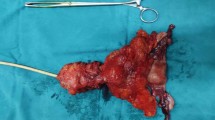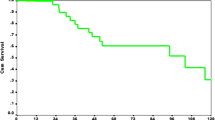Abstract
Background
Pelvic exenteration has attained an important role in the treatment of advanced or recurrent cervical cancer for obtaining a complete cure or longer disease-free survival. The purpose of this study was to evaluate patients undergoing pelvic exenteration and to determine the clinical features associated with outcome and survival.
Methods
We retrospectively analyzed the records of 12 patients who underwent pelvic exenteration for uterine cervical cancer between July 2002 and August 2011.
Results
Two patients had primary stage IVA cervical adenocarcinoma and 10 patients had recurrent cervical cancer. Eight patients underwent anterior pelvic exenteration, 3 patients underwent total pelvic exenteration, and 1 patient underwent posterior pelvic exenteration. With a median duration of follow-up of 22 months (range 3–116 months), 5 patients were alive without recurrence. Of 5 patients with no evidence of disease, 4 were recurrent or residual tumor, all of whom had common factors, such as a tumor size ≤30 mm, negative surgical margins, complete resection, and no lymph node involvement. The 5-year overall survival rate for 12 patients was 42.2 %. Ileus was the most common complication (42 %) and post-operative intestinal anastomosis leaks developed in 3 patients, but no ureteral anastomosis leaks occurred.
Conclusions
Pelvic exenteration is a feasible surgical procedure in advanced and/or recurrent cervical cancer patients with no associated post-operative mortality, and the only therapeutic option for complete cure or long-term survival; however, post-operative complications frequently occur.

Similar content being viewed by others
References
Center for Cancer Control and Information Services (2011) Vital Statistics Japan edited by Ministry of Health, Labour and Welfare. National Cancer Center. Available via DIALOG. http://ganjoho.jp/professional/statistics/statistics (page 17)
Nagase S, Inoue Y, Umesaki N et al (2010) Evidence-based guidelines for treatment of cervical cancer in Japan. Japan Society of Gynecologic Oncology (JSGO) 2007 edition. Int J Clin Oncol 15(2):117–124
Rose PG, Bundy BN, Watkins EB et al (1999) Concurrent cisplatin-based radiotherapy and chemotherapy for locally advanced cervical cancer. N Engl J Med 15;340(15):1144–1153 (Erratum in: N Engl J Med 1999 26;341(9):708)
Brader KR, Morris M, Levenback C et al (1998) Chemotherapy for cervical carcinoma: factors determining response and implications for clinical trial design. J Clin Oncol 16(5):1879–1884
Brunschwig A (1948) Complete excision of the pelvic viscera for advanced carcinoma. Cancer 1:177–183
Berek JS, Howe C, Lagasse LD et al (2005) Pelvic exenteration for recurrent gynecologic malignancy: survival and morbidity analysis of the 45-year experience at UCLA. Gynecol Oncol 99:153–159
Maggioni A, Roviglione G, Landoni F et al (2009) Pelvic exenteration: ten-year experience at the European Institute of Oncology in Milan. Gynecol Oncol 114:64–68
Jurado M, Alcazar JL, Martinez-Monge R et al (2010) Resectability rates of previously irradiated recurrent cervical cancer (PIRCC) treated with pelvic exenteration: is still the clinical involvement of the pelvis wall a real contraindication? A twenty-year experience. Gynecol Oncol 116:38–43
McLean KA, Zhang W, Dunsmoor-Su RF et al (2011) Pelvic exenteration in the age of modern chemoradiation. Gynecol Oncol 121(1):131–134
Khoury-Collado F, Einstein MH, Bochner BH et al (2012) Pelvic exenteration with curative intent for recurrent uterine malignancies. Gynecol Oncol 124(1):42–47
Husain A, Akhurst T, Larson S et al (2007) A prospective study of the accuracy of 18Fluorodeoxyglucose positron emission tomography (18FDG PET) in identifying sites of metastasis prior to pelvic exenteration. Gynecol Oncol 106:177–180
Havrilesky LJ, Wong TZ, Secord AA et al (2003) The role of PET scanning in the detection of recurrent cervical cancer. Gynecol Oncol 90(1):186–190
Rutledge FN, McGuffee VB (1987) Pelvic exenteration: prognostic significance of regional lymph node metastasis. Gynecol Oncol 26:347–380
Morely GW, Hopkins MP, Lindennaur SM et al (1989) Pelvic exenteration, University of Michigan: 100 patients at 5 years. Obstet Gynecol 74:934–942
Saunders N (1995) Pelvic exenteration: by whom and for whom? Lancet 345:5–6
Numa F, Ogata H, Suminami Y et al (1997) Pelvic exenteration for the treatment of gynecological malignancies. Arch Gynecol Obstet 259:133–138
Marnitz S, Dowdy S, Lanowska M et al (2009) Exenterations 60 years after first description: results of a survey among US and German Gynecologic Oncology Centers. Int J Gynecol Cancer 19(5):974–977
Forner DM, Lampe B (2011) Exenteration as a primary treatment for locally advanced cervical cancer: long-term results and prognostic factors. Am J Obstet Gynecol 205:148.e1–6
Benn T, Brooks RA, Zhang Q et al (2011) Pelvic exenteration in gynecologic oncology: a single institution study over 20 years. Gynecol Oncol 122:14–18
National Comprehensive Cancer Network (2006) NCCN clinical practice guidelines in oncology cervical cancer V2.2006. http://www.nccn.org/professionals/physician_gls/pdf/cervical.pdf
Marnitz S, Kohler C, Muller M et al (2006) Indication for primary and secondary exenterations in patients with cervical cancer. Gynecol Oncol 103:1023–1030
Fotopoulou C, Neumann U, Kraetschell R et al (2010) Long-term clinical outcome of pelvic exenteration in patients with advanced gynecological malignancies. J Surg Oncol 101:507–512
Conflict of interest
The authors have no conflicts of interest to declare.
Author information
Authors and Affiliations
Corresponding author
About this article
Cite this article
Tanaka, S., Nagase, S., Kaiho-Sakuma, M. et al. Clinical outcome of pelvic exenteration in patients with advanced or recurrent uterine cervical cancer. Int J Clin Oncol 19, 133–138 (2014). https://doi.org/10.1007/s10147-013-0534-9
Received:
Accepted:
Published:
Issue Date:
DOI: https://doi.org/10.1007/s10147-013-0534-9




